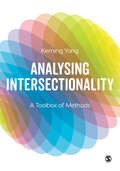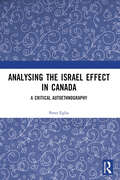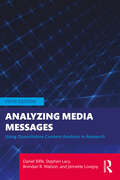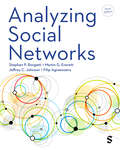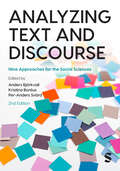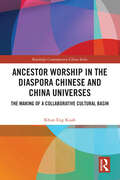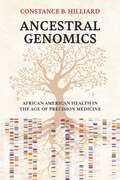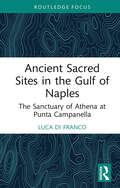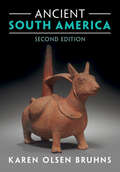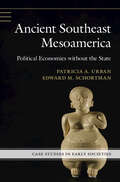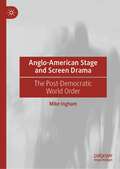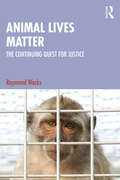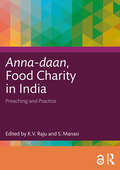- Table View
- List View
Analysing Intersectionality: A Toolbox of Methods
by Keming YangHow can we analyse the intersectional effects of multiple factors on experiences of disenfranchisement? This book equips you with the methodological tools to uncover new insights. First providing a critical examination of long-standing methodologies in intersectionality research, it then shines a spotlight on analytical techniques such as qualitative comparative analysis, multilevel models, mediation and moderation, and mixed methods designs. With chapter objectives, real-world research examples, further reading and reflective questions, it will equip you with the methodological tools to understand intersectionality in specific social settings. The book: · Bridges the gap between intersectionality as a theory and an empirical research practice. · Extends existing approaches to analysing intersectionality in a traditionally qualitative field. · Inspires creativity and celebrates a variety of effective methods for studying intersectionality. Innovative and thought-provoking, this book is ideal for any student or researcher looking to harness the power of empirical evidence to explore inequality and injustice.
Analysing the Israel Effect in Canada: A Critical AutoEthnography
by Peter EglinWhat is the life of a Palestinian worth to intellectuals in Canadian universities and news media? Analyzing the Israel Effect documents and analyzes the discursive and organizational methods by which public criticism of Israel’s oppression of the Palestinians is silenced in Canada, as experienced through ten episodes in the life of the author over a thirty-year period from 1990-2020 in interaction with his university and local and national Canadian news media.As a sociological work the book is a critical autoethnography. But it is also an atrocity tale, a horror story of institutional self-censorship amounting to the abrogation of intellectual responsibility by those specifically charged with upholding it. In the end, the book is a crossover between academic treatise and journalistic exposé, “a historical narrative written by an academic from the standpoint of a political participant-observer” (Rajan Philips). The Israel Effect itself is analyzed as a three-tier propaganda industry. Hasbara is produced in Israel (Tier 1), disseminated to Israel Lobby groups around the world (Tier 2) and independently re-produced, actively and passively, by the “intellectual” institutions – universities and news media (Tier 3). This book is about the non-Jewish, non-Zionist institutions of Tier 3, the onlookers to war crimes, ethnic cleansing and, arguably, genocide, as in Gaza in October-November 2023.This work stands as a compelling testament to the importance of preserving freedom of expression, and the vital role intellectuals play in challenging injustice and promoting transparency. It is ideal for scholars, activists, and anyone seeking to understand the complexities of political activism and the power dynamics behind public discourse.
Analysing the Israel Effect in Canada: A Critical AutoEthnography
by Peter EglinWhat is the life of a Palestinian worth to intellectuals in Canadian universities and news media? Analyzing the Israel Effect documents and analyzes the discursive and organizational methods by which public criticism of Israel’s oppression of the Palestinians is silenced in Canada, as experienced through ten episodes in the life of the author over a thirty-year period from 1990-2020 in interaction with his university and local and national Canadian news media.As a sociological work the book is a critical autoethnography. But it is also an atrocity tale, a horror story of institutional self-censorship amounting to the abrogation of intellectual responsibility by those specifically charged with upholding it. In the end, the book is a crossover between academic treatise and journalistic exposé, “a historical narrative written by an academic from the standpoint of a political participant-observer” (Rajan Philips). The Israel Effect itself is analyzed as a three-tier propaganda industry. Hasbara is produced in Israel (Tier 1), disseminated to Israel Lobby groups around the world (Tier 2) and independently re-produced, actively and passively, by the “intellectual” institutions – universities and news media (Tier 3). This book is about the non-Jewish, non-Zionist institutions of Tier 3, the onlookers to war crimes, ethnic cleansing and, arguably, genocide, as in Gaza in October-November 2023.This work stands as a compelling testament to the importance of preserving freedom of expression, and the vital role intellectuals play in challenging injustice and promoting transparency. It is ideal for scholars, activists, and anyone seeking to understand the complexities of political activism and the power dynamics behind public discourse.
Analyzing Media Messages: Using Quantitative Content Analysis in Research
by Daniel Riffe Stephen Lacy Brendan R. Watson Jennette LovejoyThe fifth edition of this comprehensive and engaging text guides readers through the essential tools and skills necessary to conduct quantitative content analysis research. Readers will find a clear definition of quantitative content analysis and step-by-step instructions on designing a content analysis study, along with examples of content analysis studies and journal articles. This edition has been updated with the latest methods in sampling in the digital age, computerized content analysis, and the uses of social media in content analysis research. It maintains the concise, accessible approach of previous editions while including refreshed examples and discussions throughout. This is an essential text for content analysis courses in communication and media studies programs at all levels, as well as a useful supplementary text in more general research methods courses.
Analyzing Media Messages: Using Quantitative Content Analysis in Research
by Daniel Riffe Stephen Lacy Brendan R. Watson Jennette LovejoyThe fifth edition of this comprehensive and engaging text guides readers through the essential tools and skills necessary to conduct quantitative content analysis research. Readers will find a clear definition of quantitative content analysis and step-by-step instructions on designing a content analysis study, along with examples of content analysis studies and journal articles. This edition has been updated with the latest methods in sampling in the digital age, computerized content analysis, and the uses of social media in content analysis research. It maintains the concise, accessible approach of previous editions while including refreshed examples and discussions throughout. This is an essential text for content analysis courses in communication and media studies programs at all levels, as well as a useful supplementary text in more general research methods courses.
Analyzing Social Networks
by Stephen P Borgatti Martin G. Everett Jeffrey C. Johnson Filip AgneessensKickstart your research with this practical, bestselling guide to doing social network analysis. Get to grips with the mathematical foundations and learn how to use software tools such as NeTDraw and UNICET to reach your research goals. Supporting you step-by-step through the entire research process, from design and data collection to coding, visualisation, and analysis, the book also offers: • Case studies and examples using real data • Exercises drawn from the authors’ decades of teaching experience • Online access to datasets, worked examples and a software manual to help you practice your skills. Whether you are new to social network analysis or an experienced researcher, this approachable book is your technical toolbox and research companion all in one.
Analyzing Social Networks
by Stephen P Borgatti Martin G. Everett Jeffrey C. Johnson Filip AgneessensKickstart your research with this practical, bestselling guide to doing social network analysis. Get to grips with the mathematical foundations and learn how to use software tools such as NeTDraw and UNICET to reach your research goals. Supporting you step-by-step through the entire research process, from design and data collection to coding, visualisation, and analysis, the book also offers: • Case studies and examples using real data • Exercises drawn from the authors’ decades of teaching experience • Online access to datasets, worked examples and a software manual to help you practice your skills. Whether you are new to social network analysis or an experienced researcher, this approachable book is your technical toolbox and research companion all in one.
Analyzing Social Networks
by Stephen P Borgatti Martin G. Everett Jeffrey C. Johnson Filip AgneessensKickstart your research with this practical, bestselling guide to doing social network analysis. Get to grips with the mathematical foundations and learn how to use software tools such as NeTDraw and UNICET to reach your research goals. Supporting you step-by-step through the entire research process, from design and data collection to coding, visualisation, and analysis, the book also offers: • Case studies and examples using real data • Exercises drawn from the authors’ decades of teaching experience • Online access to datasets, worked examples and a software manual to help you practice your skills. Whether you are new to social network analysis or an experienced researcher, this approachable book is your technical toolbox and research companion all in one.
Analyzing Text and Discourse: Nine Approaches for the Social Sciences
by Anders Björkvall Kristina Boreus Per-Anders SvärdChoose the right methodological tools to answer your research question and know how to use them with this anthology of textual analysis approaches. Each chapter provides not only relevant theoretical background behind each methodology, but also its advantages and challenges, its potential applications, and its relationship to studying social phenomenon. Through step-by-step worked examples of real-world data, you get an in-depth window into each method in action and learn how to apply the same techniques successfully and confidently in your own research. Methods include: • Content analysis • Narrative analysis • Critical discourse studies • Multimodal discourse analysis
Analyzing Text and Discourse: Nine Approaches for the Social Sciences
by Anders Björkvall Kristina Boreus Per-Anders SvärdChoose the right methodological tools to answer your research question and know how to use them with this anthology of textual analysis approaches. Each chapter provides not only relevant theoretical background behind each methodology, but also its advantages and challenges, its potential applications, and its relationship to studying social phenomenon. Through step-by-step worked examples of real-world data, you get an in-depth window into each method in action and learn how to apply the same techniques successfully and confidently in your own research. Methods include: • Content analysis • Narrative analysis • Critical discourse studies • Multimodal discourse analysis
Analyzing Text and Discourse: Nine Approaches for the Social Sciences
by Anders Björkvall Kristina Boreus Per-Anders SvärdChoose the right methodological tools to answer your research question and know how to use them with this anthology of textual analysis approaches. Each chapter provides not only relevant theoretical background behind each methodology, but also its advantages and challenges, its potential applications, and its relationship to studying social phenomenon. Through step-by-step worked examples of real-world data, you get an in-depth window into each method in action and learn how to apply the same techniques successfully and confidently in your own research. Methods include: • Content analysis • Narrative analysis • Critical discourse studies • Multimodal discourse analysis
Anarchy in Athens: An ethnography of militancy, emotions and violence (Contemporary Anarchist Studies)
by Nicholas ApoifisThe battles between Athenian anarchists and the Greek state have received a high degree of media attention recently. But away from the intensity of street protests militants implement anarchist practices whose outcomes are far less visible. They feed the hungry and poor, protect migrants from fascist beatings and try to carve out an autonomous political, social and cultural space. Activists within the movement share politics centred on hostility to the capitalist state and all forms of domination, hierarchy and discrimination. Based on extensive ethnographic fieldwork among Athenian anarchists and anti-authoritarians, Anarchy in Athens unravels the internal complexities within this milieu and provides a better understanding of the forces that give the space its shape.
Ancestor Worship in the Diaspora Chinese and China Universes: The Making of a Collaborative Cultural Basin (ISSN)
by Khun Eng KuahKuah explores the centrality of ancestors and ancestor worship of the Chinese in the Diaspora Chinese and China universes. Building on the original work and book on “Rebuilding the Ancestral Village: Singaporeans in China”, this book goes beyond the premise of remaking the ancestral home.Ancestor worship and the ancestors, together with selected cultural practices, constitute an important aspect of the broad Chinese culture shared by these two groups of Chinese and leads to the making of a collaborative cultural basin. This book takes the audience on an ancestor worship journey to uncover the complexity of ancestors and ancestral souls crossing transnational spaces, their choices of ancestral soul homes, the significance of the lineage ancestral house and the engagement of women through food offering contesting patriarchy. It also explores the increasing role of the Mainland Chinese state in appropriating ancestor and ancestor worship as a cultural icon and during the Qingming festival as a socio-moral capital and cultural bridge to foster closer ties with the Diaspora Chinese in its attempt to bring them into its “Chinese civilizational polity”. The book also takes the audience on a photographic journey to visually experience the various rituals and the vibrancy of the ritual performances conducted during the different stage from pre-communal to communal ancestor worship.An essential read for scholars of Chinese society and religion, Chinese migration and diaspora studies.
Ancestor Worship in the Diaspora Chinese and China Universes: The Making of a Collaborative Cultural Basin (ISSN)
by Khun Eng KuahKuah explores the centrality of ancestors and ancestor worship of the Chinese in the Diaspora Chinese and China universes. Building on the original work and book on “Rebuilding the Ancestral Village: Singaporeans in China”, this book goes beyond the premise of remaking the ancestral home.Ancestor worship and the ancestors, together with selected cultural practices, constitute an important aspect of the broad Chinese culture shared by these two groups of Chinese and leads to the making of a collaborative cultural basin. This book takes the audience on an ancestor worship journey to uncover the complexity of ancestors and ancestral souls crossing transnational spaces, their choices of ancestral soul homes, the significance of the lineage ancestral house and the engagement of women through food offering contesting patriarchy. It also explores the increasing role of the Mainland Chinese state in appropriating ancestor and ancestor worship as a cultural icon and during the Qingming festival as a socio-moral capital and cultural bridge to foster closer ties with the Diaspora Chinese in its attempt to bring them into its “Chinese civilizational polity”. The book also takes the audience on a photographic journey to visually experience the various rituals and the vibrancy of the ritual performances conducted during the different stage from pre-communal to communal ancestor worship.An essential read for scholars of Chinese society and religion, Chinese migration and diaspora studies.
Ancestral Future (Critical South)
by Ailton KrenakIn response to the damage caused by centuries of colonial ravaging and the current ecological, political and social crises, the leading Indigenous thinker and activist Ailton Krenak warns against the power of corporate capitalism and its destructive impact. Capitalism encroaches on every corner of the planet and orients us toward a future of promised progress, achievement and growth, but this future doesn’t exist – we just imagine it. This orientation to the future also blinds us to what exists around us, to the plants and animals with which we share the Earth and to the rivers that flow through our lands. Rivers are not just resources to be exploited by us or channels to carry away our waste, they are beings that connect us with our past. If there is a future to imagine, it is ancestral, since it is already present in the here and now and in that which exists around us, in the rivers and mountains and trees that are our kin. In a spoken language that has the mark of ancestral oral wisdom, Krenak offers a new perspective that challenges and disrupts some of the assumptions that underpin Western attitudes and mentalities. His work will be of great interest to anyone concerned about the climate crisis and the worsening plight of our planet.
Ancestral Genomics: African American Health in the Age of Precision Medicine
by Constance B. HilliardA leading evolutionary historian offers a radical solution to racial health disparities in the United States.Constance B. Hilliard was living in Japan when she began experiencing joint pain. Her doctor diagnosed osteoarthritis—a common ailment for someone her age. But her bloodwork showed something else: Hilliard, who had never had kidney problems, appeared to be suffering from renal failure. When she returned to Texas, however, a new round of tests showed that her kidneys were healthy. Unlike the Japanese doctor, her American primary care provider had checked a box on her lab report for “African American.” As a scholar of scientific racism, Hilliard was perplexed. Why should race, which experts agree has no biological basis, matter for getting accurate test results?Ancestral Genomics is the result of Hilliard’s decade-long quest to solve this puzzle. In a masterful synthesis of evolutionary history, population genetics, and public health research, she addresses the usefulness of race as a heuristic in genomic medicine. Built from European genetic data, the Human Genome Project and other databases have proven inadequate for identifying disease-causing gene variants in patients of African descent. Such databases, Hilliard argues, overlook crucial information about the environments to which their ancestors’ bodies adapted prior to the transatlantic slave trade. Hilliard shows how, by analyzing “ecological niche populations,” a classification model that combines family and ecological histories with genetic information, our increasingly advanced genomic technologies, including personalized medicine, can serve African Americans and other people of color, while avoiding racial essentialism.Forcefully argued and morally urgent, Ancestral Genomics is a clarion call for the US medical community to embrace our multigenomic society.
Ancient Sacred Sites in the Gulf of Naples: The Sanctuary of Athena at Punta Campanella (Young Feltrinelli Prize in the Moral Sciences)
by Luca Di FrancoThe geographical position between the gulfs of Naples and Salerno made pre-Roman Sorrento a fundamental point of passage. Around the inhabited centre, sacred sites or scattered settlements developed, including the sanctuary of Athena on the extreme tip of the peninsula near Punta Campanella. This book explores the historical development of the sanctuary from the 6th century BC to the 1st century AD. Drawing on partly unpublished archaeological documentation and literary sources, the book provides useful elements for understanding the site and its relationship with the surrounding area. Sorrento and the Greek presence in the Gulf of Naples are linked to the sanctuary installation, perhaps first dedicated to the Sirens but surely after to Athena. Judging from literary sources, it was one of the best-known places of worship in ancient Italy. It was only in the 1980s that the discovery of an Oscan inscription with a dedication to Minerva made it possible to hypothesise the presence of a sanctuary near the Medieval tower at Punta Campanella. The analysis of the archaeological documentation known until now, the study of the new archaeological plans and the material culture (ceramics) from the site make it possible to better understand the development and the importance of the sanctuary. This book, therefore, defines the historical and territorial development of the sanctuary of Athena, reconstructing the history of the territory of ancient Surrentum and, above all, its most important sanctuary. The book will be of particular interest to archaeologists, ancient historians and historians of religion.
Ancient Sacred Sites in the Gulf of Naples: The Sanctuary of Athena at Punta Campanella (Young Feltrinelli Prize in the Moral Sciences)
by Luca Di FrancoThe geographical position between the gulfs of Naples and Salerno made pre-Roman Sorrento a fundamental point of passage. Around the inhabited centre, sacred sites or scattered settlements developed, including the sanctuary of Athena on the extreme tip of the peninsula near Punta Campanella. This book explores the historical development of the sanctuary from the 6th century BC to the 1st century AD. Drawing on partly unpublished archaeological documentation and literary sources, the book provides useful elements for understanding the site and its relationship with the surrounding area. Sorrento and the Greek presence in the Gulf of Naples are linked to the sanctuary installation, perhaps first dedicated to the Sirens but surely after to Athena. Judging from literary sources, it was one of the best-known places of worship in ancient Italy. It was only in the 1980s that the discovery of an Oscan inscription with a dedication to Minerva made it possible to hypothesise the presence of a sanctuary near the Medieval tower at Punta Campanella. The analysis of the archaeological documentation known until now, the study of the new archaeological plans and the material culture (ceramics) from the site make it possible to better understand the development and the importance of the sanctuary. This book, therefore, defines the historical and territorial development of the sanctuary of Athena, reconstructing the history of the territory of ancient Surrentum and, above all, its most important sanctuary. The book will be of particular interest to archaeologists, ancient historians and historians of religion.
Ancient South America
by null Karen Olsen BruhnsAncient South America, 2nd edition features the full panorama of the South American past from the first inhabitants to the European invasions Isolated for all of prehistory and much of history, the continent witnessed the rise of cultures and advanced civilizations rivalling those of Europe, Asia, and Africa. Independently of developments elsewhere, South American peoples invented agriculture, domesticated animals, and created pottery, elaborate architecture, and the arts of working metals. Tribes, chiefdoms, and immense conquest states rose, flourished, and disappeared, leaving only their ruined monuments and broken artifacts as testimonials to past greatness. This new edition is completely revised and updated to reflect archaeological discoveries and insights made in the past three decades. Incorporating new findings on northern and eastern lowlands, and discussions of the first civilizations, it also examines the first inhabitants of Brazil and Patagonia as well as the Andes. Accessibly written and abundantly illustration, the volume also includes chronological charts and new examples.
Ancient Southeast Mesoamerica: Political Economies without the State (Case Studies in Early Societies)
by null Patricia A. Urban null Edward M. SchortmanAncient Southeast Mesoamerica explores the distinctive development and political history of the region from its earliest inhabitants up to the Spanish conquest. It was composed of a matrix of social networks rather than divided by distinct cultures and domains. Making use of the area's rich archaeological data, Edward Schortman and Patricia Urban provide a social network analysis of southeast Mesoamerica. They demonstrate how inhabitants from different locales were organized within such networks, and how they mobilized the assets that they needed to define and achieve their own goals. The also provide evidence for the actions of other groups, who sought to promote their importance at local and regional scales, and often opposed those efforts. Schortman and Urban's study demonstrates the fresh insights gained from study of socio-political structures via a social network perspective. It also challenges models that privilege the influence of powerful leaders in shaping those structures.
Angels and Other Cows: A Celestial Adventure into AI Worlds, the Social Good, and Unknown Connections (Artificial Intelligence, Simulation and Society)
by Petra AhrweilerThis open access novel uses fantasy and romance to pique readers' interest in understanding how AI technologies can be used for social justice across very different political and social terrains. Can you truly reach out to somebody who is in every aspect the direct opposite of yourself? Gabriel and Tilda, the two protagonists of this futuristic novel, are very different people. They work at a Berlin-based international aid company, and the only thing they can agree on is that the world is in a shambles: Scarce public resources, conflict and crises, inequalities, religious and socio-cultural belief systems that cement social injustice, have created a world as deeply divided and set apart as Gabriel and Tilda. They are sent on company business to recruit international partners for a social development project on global justice, and start travelling the world together. On their adventurous journey through many countries, they learn about the impacts of culture on social welfare systems, while trying to define their own relationship, which is intermingled with generational power games and milieu-specific worldview struggles. In Gabriel and Tilda’s attempts to bridge the deep gulf between their personalities, the novel creates a metaphor for finding a cohesive model of global justice using artificial intelligence that can integrate highly contextualized, national value cultures. Gabriel and Tilda are supported by two guardian angels: Assigned to save the planet through interpersonal and intercultural integration, the angels GA and TA team up with English Benedictine monk and mystic guru Bede Griffiths who is very keen to help Tilda and Gabriel in their model pilot of unlikely love.
Anglo-American Stage and Screen Drama: The Post-Democratic World Order
by Mike InghamAnglo-American Stage and Screen Drama analyses and discusses the contemporary role of stage and screen drama as a critical forum for progressive thinking in an increasingly polarised geopolitical world. The book addresses the cultural politics of socially engaged 21st century stage plays and films, and makes the case for drama as a sociopolitical forum, in which the complex and contentious issues that confront society can be explored and debated. It conceives of Anglophone political drama as a significant intervention in today’s culture wars, representing the latter as a convenient distraction from the ongoing depredations of neoliberalism. In the main part of the book selected case-study plays and films from each of the first two decades illustrate drama’s capacity to influence critical debate on social justice issues. All of the case-study texts under discussion express a powerful aesthetics of resistance to right-wing ideology, and promote inclusive and enlightened values. This broader orientation underlines drama’s role as a channel for critical agency in today’s putative post-socialist, post-democratic climate.
Animal Lives Matter: The Continuing Quest for Justice
by Raymond WacksAnimal Lives Matter provides a comprehensive analysis of the legal, philosophical, and ethical aspects of animal rights. It argues that the subject extends beyond the matter of our obligations towards animals, to include our wider responsibilities for protecting the environment. Drawing on numerous moral, political, legal, religious, and philosophical theories including utilitarianism, deontology, rights theory, social contractarianism, and the capabilities approach, the author meticulously examines the questions of sentience, speciesism, personhood, and human exceptionalism. Lucid, nuanced, and academically rigorous, this important book will be an essential resource for scholars of law, politics, philosophy, ethics, as well as policy makers and the general reader.
Animal Lives Matter: The Continuing Quest for Justice
by Raymond WacksAnimal Lives Matter provides a comprehensive analysis of the legal, philosophical, and ethical aspects of animal rights. It argues that the subject extends beyond the matter of our obligations towards animals, to include our wider responsibilities for protecting the environment. Drawing on numerous moral, political, legal, religious, and philosophical theories including utilitarianism, deontology, rights theory, social contractarianism, and the capabilities approach, the author meticulously examines the questions of sentience, speciesism, personhood, and human exceptionalism. Lucid, nuanced, and academically rigorous, this important book will be an essential resource for scholars of law, politics, philosophy, ethics, as well as policy makers and the general reader.
Anna-daan, Food Charity in India: Preaching and Practice
by K. V. Raju S. ManasiEating together unites people and has a significant impact on their physical, social, and emotional development. This book looks at practices and traditions of sharing food prevalent among major religious communities in India, including Hinduism, Buddhism, Jainism, Sikhism, Christianity, and Islam.Food insecurity is one of the major problems every country in the world is facing today because of increasing population, climate change, agrarian distress, wars and conflicts, and the COVID-19 pandemic. Including case studies from across India, this book examines the necessity and effectiveness of food-sharing practices in temples, mosques, and gurudwaras, among others. Emphasising the importance of these practices for the social and physical well-being of the most vulnerable sections of society, it showcases how traditional religious practices of food sharing have contributed to tackling hunger, especially during the COVID-19 pandemic. The volume also offers long-term solutions to address underlying issues which cause hunger and food insecurity.One of the first to study food sharing and alms-giving practices in India, this book will be an essential read for scholars and researchers of sociology, anthropology, food studies, religion, security studies, political economy, public policy, and South Asian history and culture.
